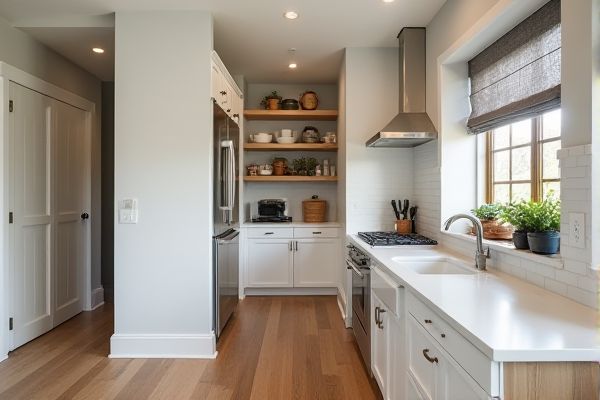
An integrated pantry blends seamlessly with your kitchen cabinetry, offering a sleek, modern look that maximizes space efficiency, while a separate pantry provides ample storage and easy access without cluttering the main kitchen area. Discover which pantry style best suits Your lifestyle and kitchen layout by exploring the full article.
Table of Comparison
| Feature | Integrated Pantry | Separate Pantry |
|---|---|---|
| Location | Inside the kitchen area | Separate room or closet outside kitchen |
| Space Efficiency | Maximizes kitchen space, compact | Requires additional space, spacious storage |
| Accessibility | Quick access during cooking | Requires stepping out; less convenient |
| Storage Capacity | Limited by kitchen dimensions | Higher capacity for bulk storage |
| Cost | Lower construction and design cost | Higher cost for separate room build |
| Design Flexibility | Limited to kitchen layout | Customizable, can include extra features |
| Cleanliness and Organization | More exposed to kitchen mess | Easier to maintain separate clean zone |
| Value Addition | Moderate increase in home value | Significant impact on resale value |
Understanding Integrated Pantries: An Overview
Integrated pantries are designed to blend seamlessly with your kitchen cabinetry, offering a sleek and space-saving storage solution. This approach maximizes kitchen efficiency by keeping essentials within reach while maintaining a cohesive aesthetic. Your choice between an integrated pantry and a separate pantry depends on available space, storage needs, and design preferences.
What Defines a Separate Pantry?
A separate pantry is a dedicated room or enclosed space specifically designed for food storage, distinct from the kitchen area. It typically features shelving units, cabinets, and sometimes countertops to organize groceries, canned goods, and kitchen supplies efficiently. This separation helps reduce kitchen clutter and provides ample storage, enhancing overall kitchen functionality and cleanliness.
Space Efficiency: Integrated vs Separate Pantry
An integrated pantry maximizes space efficiency by seamlessly blending into kitchen cabinetry, reducing the need for additional floor area and creating a streamlined appearance. Separate pantries require dedicated space, often occupying an entire room or closet, which can limit kitchen layout flexibility but offer more extensive storage capacity. Choosing between integrated and separate pantries depends on balancing available kitchen space with storage needs and organizational preferences.
Aesthetic Impact on Kitchen Design
An integrated pantry seamlessly blends with your kitchen cabinetry, creating a streamlined and cohesive aesthetic that enhances the overall design. Separate pantries, while offering more storage flexibility, can disrupt the visual flow and make the kitchen feel less spacious. Choosing an integrated pantry maximizes clean lines and can increase your kitchen's modern appeal.
Storage Capacity Comparison
An integrated pantry typically offers limited storage capacity, making it ideal for smaller kitchens or for those who prioritize a streamlined look. Separate pantries provide significantly more space, accommodating bulkier items and extensive food supplies, which benefits larger households or serious home cooks. Your choice should depend on whether maximizing storage capacity or maintaining cohesion with kitchen design is more important.
Organization and Accessibility
An integrated pantry promotes seamless organization by combining storage within kitchen cabinetry, enabling quick access to frequently used items while maintaining a streamlined appearance. In contrast, a separate pantry offers expanded storage capacity with distinct shelving systems, facilitating systematic categorization and easy retrieval of bulk supplies. Both options enhance accessibility, but integrated pantries prioritize immediate convenience, whereas separate pantries support comprehensive organization for larger inventories.
Cost Considerations
Integrated pantries typically incur higher upfront costs due to custom cabinetry and seamless design integration, enhancing kitchen aesthetics but increasing expenses. Separate pantries often offer a more budget-friendly option with standard shelving and standalone storage units, reducing initial investment and allowing flexible placement. Assessing your kitchen space and long-term value will help determine if your cost priorities align better with integrated elegance or separate pantry affordability.
Maintenance and Cleaning Differences
Integrated pantries offer streamlined maintenance due to their built-in design, which minimizes gaps and surfaces where dust and debris can accumulate, making cleaning more efficient. Separate pantries often require more effort to maintain because their standalone structure includes more edges, corners, and exposed areas that collect dirt and require frequent attention. Additionally, integrated pantry materials are typically selected to match kitchen finishes, facilitating uniform cleaning products and techniques, whereas separate pantries may need specialized care depending on their distinct construction.
Ideal Scenarios for Integrated Pantries
Integrated pantries are ideal for compact kitchens where space optimization is essential, offering seamless storage solutions that blend with cabinetry. You benefit from easy access to frequently used items while maintaining a clean, streamlined look. This setup works best in modern homes prioritizing functionality without sacrificing aesthetics.
Choosing Between Integrated and Separate Pantries: Key Takeaways
Integrated pantries maximize kitchen space by blending seamlessly with cabinetry, offering streamlined storage and easier access to ingredients during cooking. Separate pantries provide larger, dedicated storage areas ideal for bulk items and organized food management, especially valuable in homes with ample space. Selecting between these options depends on kitchen size, storage needs, and lifestyle preferences, balancing convenience against capacity and design integration.
 homyna.com
homyna.com